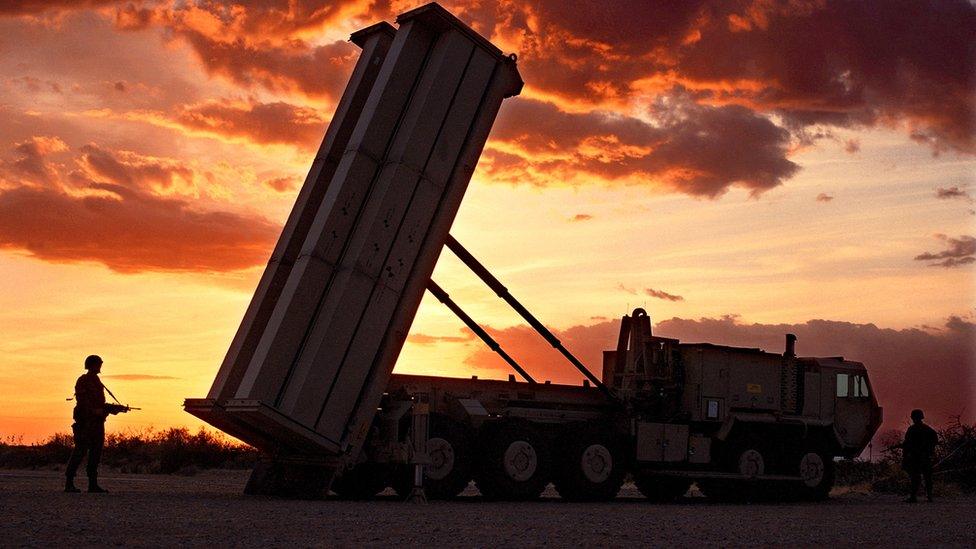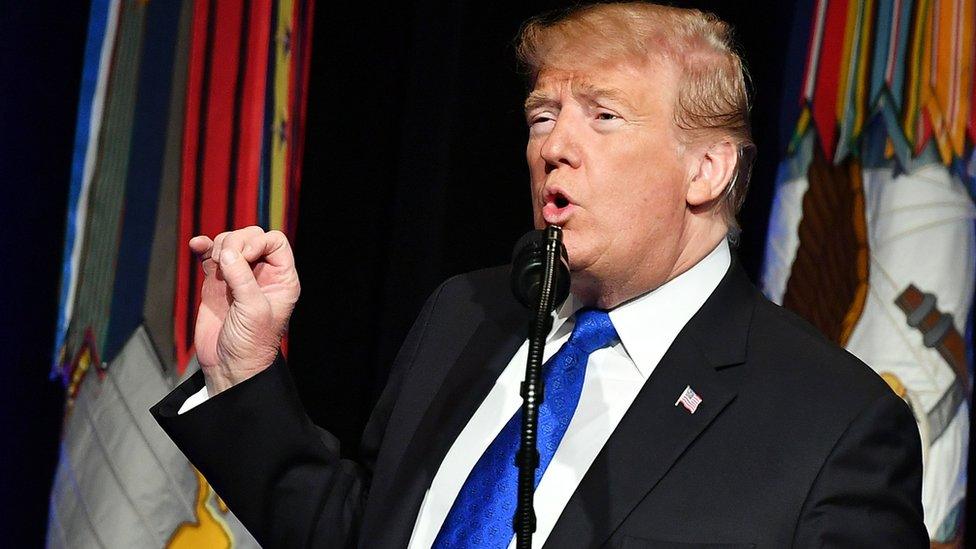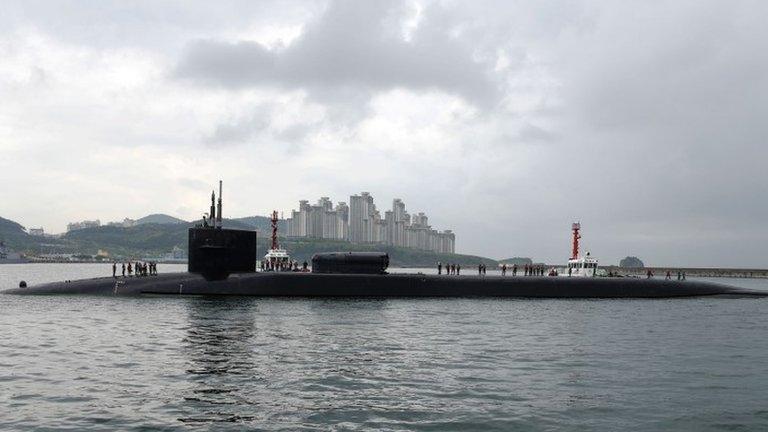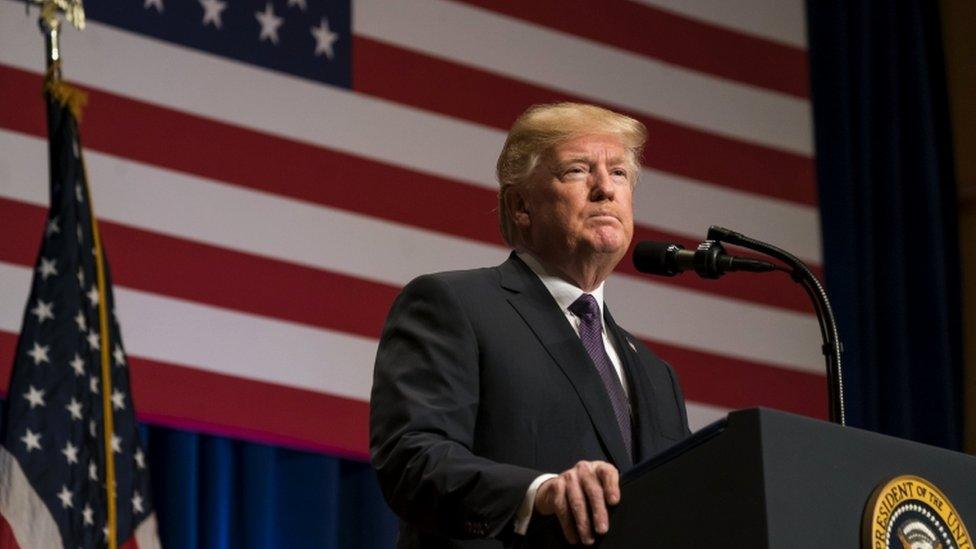US defence review: Is Trump risking a new arms race?
- Published

The US military has missile defence systems around the world
Inevitably, with its desire for new space-based sensors to detect ballistic missile launches and even the possibility of space-based interceptors to destroy attacking warheads, this review of the US missile defence strategy is bound to raise comparison with President Ronald Reagan's abortive "Star Wars" programme of the early 1980s.
Indeed at one point in his presentation, Donald Trump seemed to be echoing his predecessor, when he spoke of a missile defence programme that might "shield every city in the United States".
Mr Trump's own presentation was at times rambling and pugnacious. It was hard to determine the exact direction of missile defence under his leadership other than that it is going to be bigger and better than before. The US, he said "had to outpace all adversaries... it must be several steps ahead of those who would harm us".
But what is clear is that what the president is proposing marks a significant shift in Washington's approach to missile defence. In its own way, it could be as destabilising to the strategic balance as President Reagan's abortive plans threatened to be at the height of the Cold War.
Throughout the Cold War years missile defence (Anti-Ballistic Missile Systems as they were then known) were feasible but strictly limited by agreement (the so-called ABM Treaty) between the United States and the Soviet Union. The fear always was that such defences could undermine nuclear deterrence, by leading countries to believe they could reduce the impact of a follow-on nuclear attack. President Reagan's idea of a missile-proof shield proved to be an illusion - astronomically expensive, even if the technology had existed.
But times change and the potential threats change with them. In December 2001 the then US President, George W Bush, decided to abandon the ABM treaty to enable the development of limited missile defences against the specific threat from so-called rogue states like Iran and North Korea. To some extent it seemed fanciful at the time, but in the ensuing decades North Korea's missile development programme has moved on at a remarkable pace, giving it the ability, according to some experts, to strike at targets on the US western sea-board.

President Trump unveiled the missile defence review at the Pentagon
Over the years there have been additional elements added to the defensive system. There are two interceptor sites in the continental United States - in Alaska and California. Many US warships have the capacity to provide a form of mobile missile defence. Land-based systems are active in Romania; another is being built in Poland. And more mobile systems have been deployed in South Korea, Guam, and Japan. Missile defence has been expanded to be able to offer some protection to Washington's allies, as well as US forces deployed in the field.
All this is now to be expanded. At one level things will not change. The Missile Defence Review states clearly that "US missile defence capabilities will be sized to provide continuing effective protection of the US homeland against rogue states' offensive missile threats".
These systems are not apparently directed at either Russia or China. The document says: "The US relies upon nuclear deterrence to address the large and more sophisticated Russian and Chinese intercontinental ballistic missile capabilities….."
But, and it is a significant but, the whole strategic context has changed. Russia is a more assertive power. China is fast becoming what the American military terms "a pacing competitor", ie the benchmark against which America's own capabilities must be measured. Russia in particular, but China too, has never much liked Washington's missile defence plans. And they are going to like Mr Trump's programme even less.

North Korea's testing on ballistic missiles has alarmed its neighbours and the US
While stressing the importance of defending the US population, Mr Trump wants to significantly enhance the regional aspect of missile defence. This could inevitably mean countering Russian and Chinese systems in Europe and the Pacific.
Mr Trump also says he wants to protect the United States against all types of missile attack including from advanced cruise missiles and hypersonic missiles that travel at frightening velocities and can change direction as well. These are technologies that both Moscow and Beijing (and Washington it must be said) are exploring to give themselves a strategic edge.
Some element of an up-to-date defensive system may well be a useful hedge against the so-called rogue actors or an accidental launch. But enhanced and significantly expanded defences risk ushering in a new arms race in offensive weapons. The fact that this comes at a time when the whole fabric of arms control is fraying worries many strategic experts. The age-old strategic debate between offence and defence has just been given a new and dangerous twist.
Then there are the perennial questions of cost and capability. Congress has been willing to give lots more money for missile defence. But shifts in control of the House of Representatives and the huge demands elsewhere in the defence budget to re-equip and re-orientate America's armed forces for a new age of big-power confrontation mean that even Washington's voluminous defence budget cannot do everything.
Then there is the fundamental question, will it all work? The technical challenges are immense. Huge question marks surround the capability of those defensive systems already deployed. Many of the esoteric new offensive technologies being developed pose even greater challenges. And it is always cheaper and easier to overwhelm defences - however good - with more and more attacking missiles.
- Published4 December 2018

- Published2 February 2018

- Published28 February 2017
- Published18 December 2017

- Published10 August 2018
